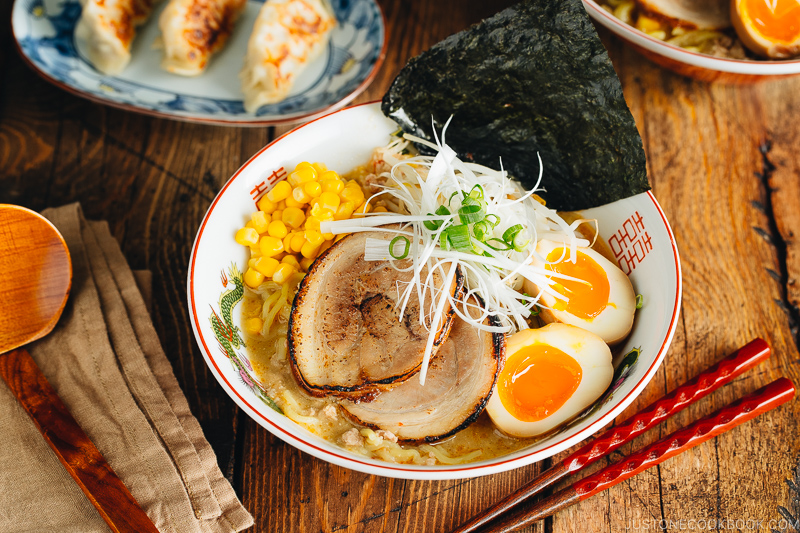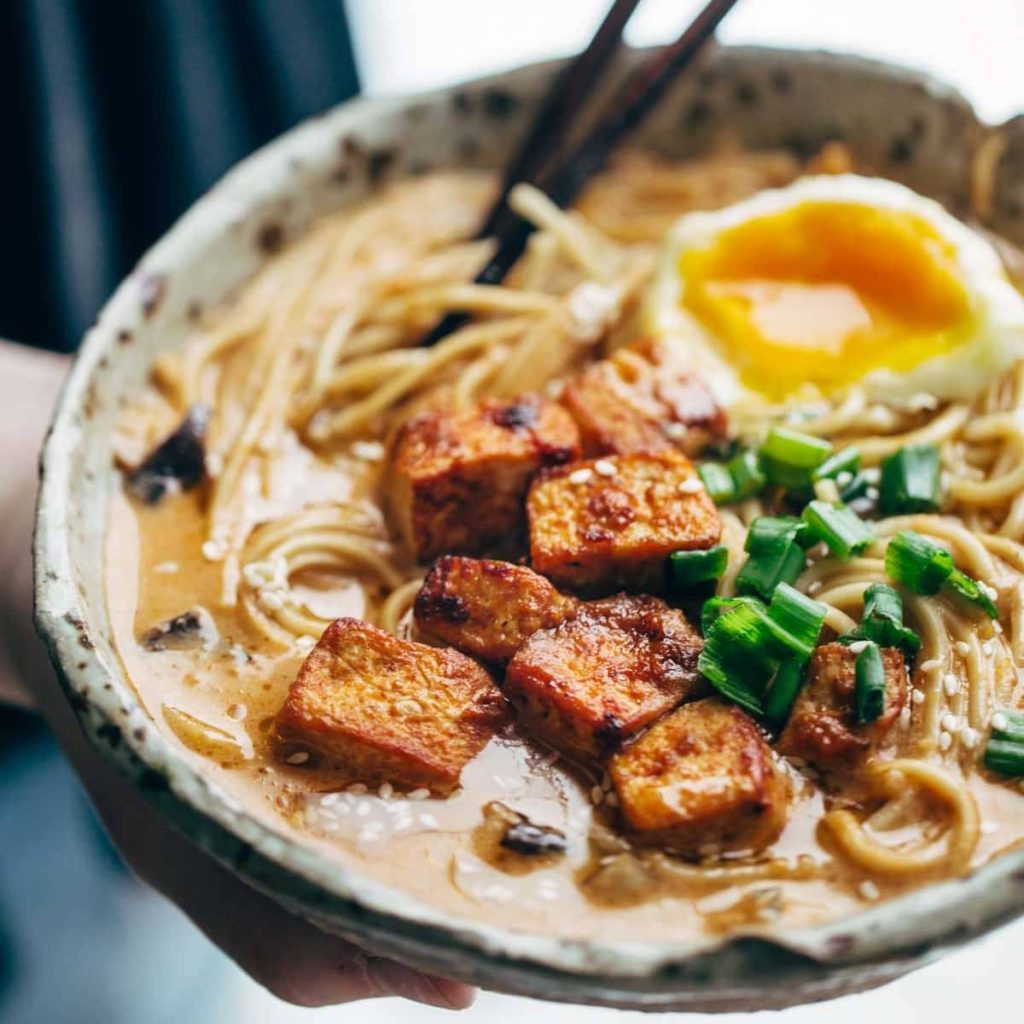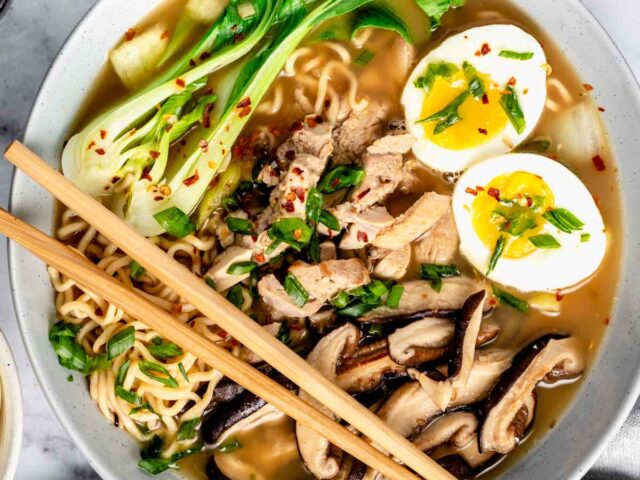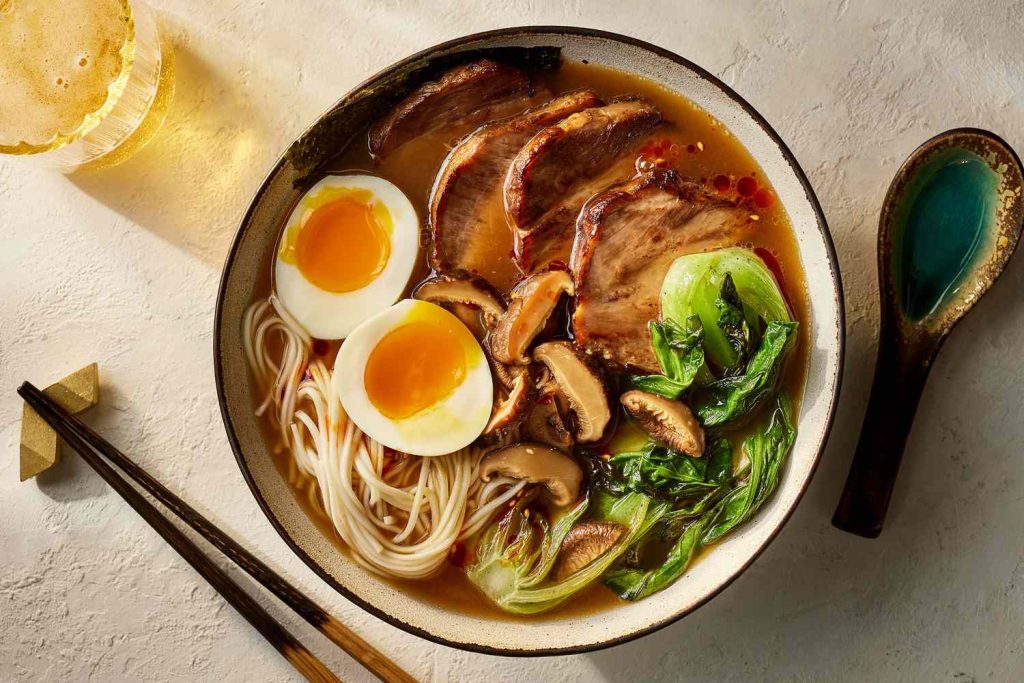The Japanese Tonkotsu Vegetarian Ramen recipe takes the renowned Tonkotsu Ramen and transforms it into a flavorful and satisfying dish suitable for vegetarians. This recipe provides an excellent alternative for those seeking a meat-free version of the beloved Japanese comfort food.
While Tonkotsu Ramen traditionally features a rich and creamy pork-based broth, this vegetarian adaptation showcases a plant-based twist. By carefully selecting ingredients and employing clever techniques, this recipe manages to capture the essence of the original while offering a delightful vegetarian experience.
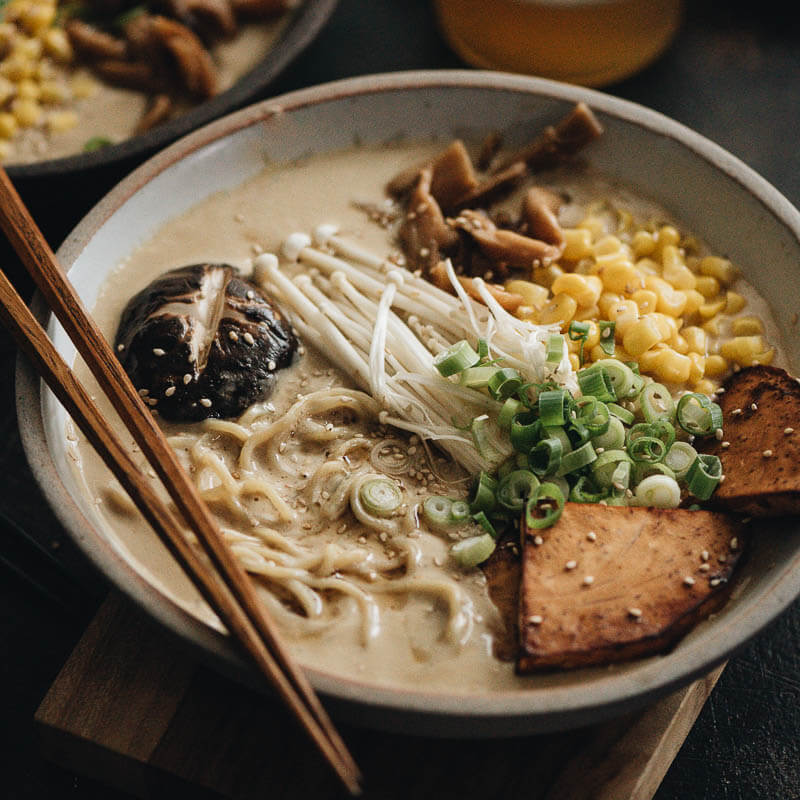
Tonkotsu Vegetarian Ramen
Ingredients
Equipment
Method
- Take a large pan.
- Add the butter and let it meltdown.
- Add in the tamari paste.
- Mix the tamari paste for two minutes.
- Add the chopped garlic and mixed vegetables.
- Add in the salt and pepper.
- Add in the tonkotsu broth and rest of the ingredients in the end.
- Mix all the ingredients well and then dish them out.
- Garnish the fresh chopped chives on top.
- Your dish is ready to be served.
Video
Notes
FAQs
Q: What makes this Tonkotsu Ramen recipe vegetarian?
A: This Tonkotsu Ramen recipe is vegetarian because it excludes any meat or meat-based ingredients typically found in traditional Tonkotsu Ramen. Instead, it utilizes a combination of plant-based ingredients and seasonings to create a flavorful and satisfying vegetarian broth.
Q: What are the key ingredients used to achieve the creamy texture in the vegetarian broth?
A: The creamy texture in the vegetarian broth is achieved by using ingredients such as miso paste, soy milk, or plant-based cream. These ingredients contribute to the richness and thickness of the broth, replicating the creamy consistency found in traditional Tonkotsu Ramen.
Q: Can I customize the toppings in this vegetarian ramen recipe?
A: Absolutely! The toppings in this vegetarian ramen recipe can be customized according to personal preferences. You can add a variety of vegetables like mushrooms, spinach, corn, or bean sprouts. Additionally, you can include extras like soft-boiled eggs, seaweed sheets, or sesame seeds for added flavor and texture.
Q: Can I make the vegetarian broth in advance?
A: Yes, you can make the vegetarian broth in advance. In fact, preparing the broth ahead of time allows the flavors to meld and intensify. Simply store the broth in an airtight container in the refrigerator and reheat it when ready to serve.

Q: Can I make this recipe vegan-friendly?
A: Yes, with a few modifications, this recipe can be made vegan-friendly. Ensure that all the ingredients used, including miso paste and soy sauce, are vegan-certified or free from animal-derived ingredients. You can also substitute dairy-based ingredients like cow’s milk or cream with plant-based alternatives such as soy milk or coconut cream.
Q: Can I use pre-packaged noodles for this ramen recipe?
A: While pre-packaged noodles can be used for convenience, for the best results, it is recommended to use fresh or refrigerated ramen noodles. These noodles have a superior texture and flavor compared to instant varieties. You can find them in Asian grocery stores or sometimes in the produce section of your local supermarket.
Q: Can I freeze the leftover vegetarian ramen?
A: It is not recommended to freeze the assembled ramen bowls, as the noodles and toppings may not retain their optimal texture after thawing. However, you can store the leftover broth and toppings separately in the refrigerator for a day or two and reheat them when ready to enjoy. Cook fresh noodles separately when serving the leftovers.
Q: Can I adjust the level of spiciness in this vegetarian ramen recipe?
A: Absolutely! The level of spiciness can be adjusted to suit your preference. If you enjoy some heat, you can add chili flakes, chili oil, or a spicy Asian sauce like Sriracha to the broth. Adjust the amount according to your desired level of spiciness.
Cooking tips
Certainly! Here are some cooking tips to help you achieve the best results with your Japanese Tonkotsu Vegetarian Ramen:
1. Simmer the broth for a longer time: To develop rich flavors and achieve a creamy consistency, simmer the vegetarian broth for an extended period. This allows the flavors to meld together and intensify, resulting in a more robust and satisfying broth.
2. Incorporate umami-rich ingredients: Since Tonkotsu Ramen is known for its umami flavors, it’s important to incorporate ingredients that enhance the savory profile of the dish. Consider adding dried mushrooms, kombu (kelp), or nutritional yeast to the broth to boost its umami depth.
3. Toast the spices and aromatics: For an extra layer of flavor, toast the spices and aromatics like garlic, ginger, and onions before adding them to the broth. This process helps to release their natural oils and intensifies their flavors, contributing to a more robust broth.
4. Adjust seasoning carefully: The balance of flavors is crucial in Tonkotsu Ramen. Be mindful when adding salt, soy sauce, or other seasonings to the broth. Start with a smaller amount and gradually adjust to your taste preferences, as the flavors can concentrate during the simmering process.
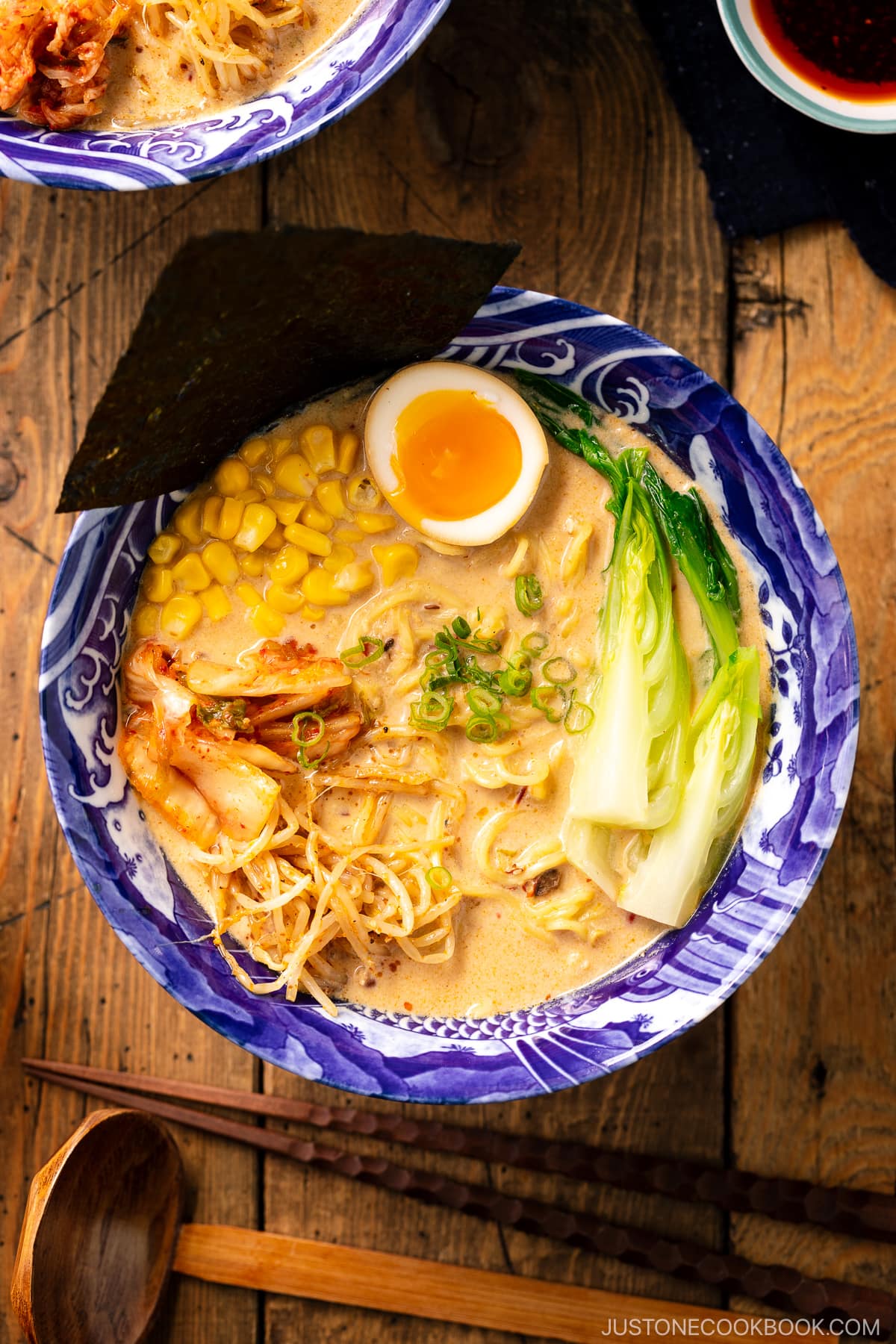
5. Preheat the bowls: To keep the ramen hot for longer, preheat the serving bowls by filling them with hot water before assembling the dish. This helps to maintain the ideal temperature of the broth and ensures a more enjoyable dining experience.
6. Cook the noodles al dente: Pay close attention to the cooking time of the noodles to achieve the perfect texture. Cook the noodles until they are al dente, which means they still have a slight firmness when bitten. Overcooking the noodles can result in a mushy and less enjoyable ramen experience.
7. Use tongs to assemble the toppings: When placing the toppings in the ramen bowls, use tongs to arrange them neatly and evenly. This helps to distribute the toppings throughout the bowl, ensuring each bite is a harmonious combination of flavors and textures.
8. Serve the ramen immediately: Ramen is best enjoyed fresh and piping hot. Assemble the bowls just before serving to ensure the noodles are hot and the toppings are fresh. This guarantees that you experience the full impact of the flavors and textures in each bowl.
By following these cooking tips, you’ll be well on your way to creating a delicious and authentic Japanese Tonkotsu Vegetarian Ramen that showcases the flavors and textures you love. Enjoy the process of crafting this comforting bowl of goodness!
Serving Suggestions
Serving Suggestions:
To elevate your dining experience with Japanese Tonkotsu Vegetarian Ramen, consider the following serving suggestions:
1. Add a variety of toppings: Offer an array of toppings for your guests to customize their ramen bowls. Some popular options include sliced green onions, bean sprouts, bamboo shoots, corn kernels, shredded nori (seaweed), and sesame seeds. These toppings not only add visual appeal but also provide different textures and flavors.
2. Include a side of pickles or kimchi: Serve a side dish of Japanese pickles (tsukemono) or Korean kimchi alongside the ramen. The tangy and crunchy pickles or spicy and fermented kimchi complement the richness of the ramen broth, providing a refreshing and contrasting element to the meal.
3. Offer condiments: Place condiments like soy sauce, chili oil, and sesame oil on the table, allowing guests to adjust the flavors according to their preferences. These condiments can add an extra kick of umami, spice, or nuttiness to the ramen.
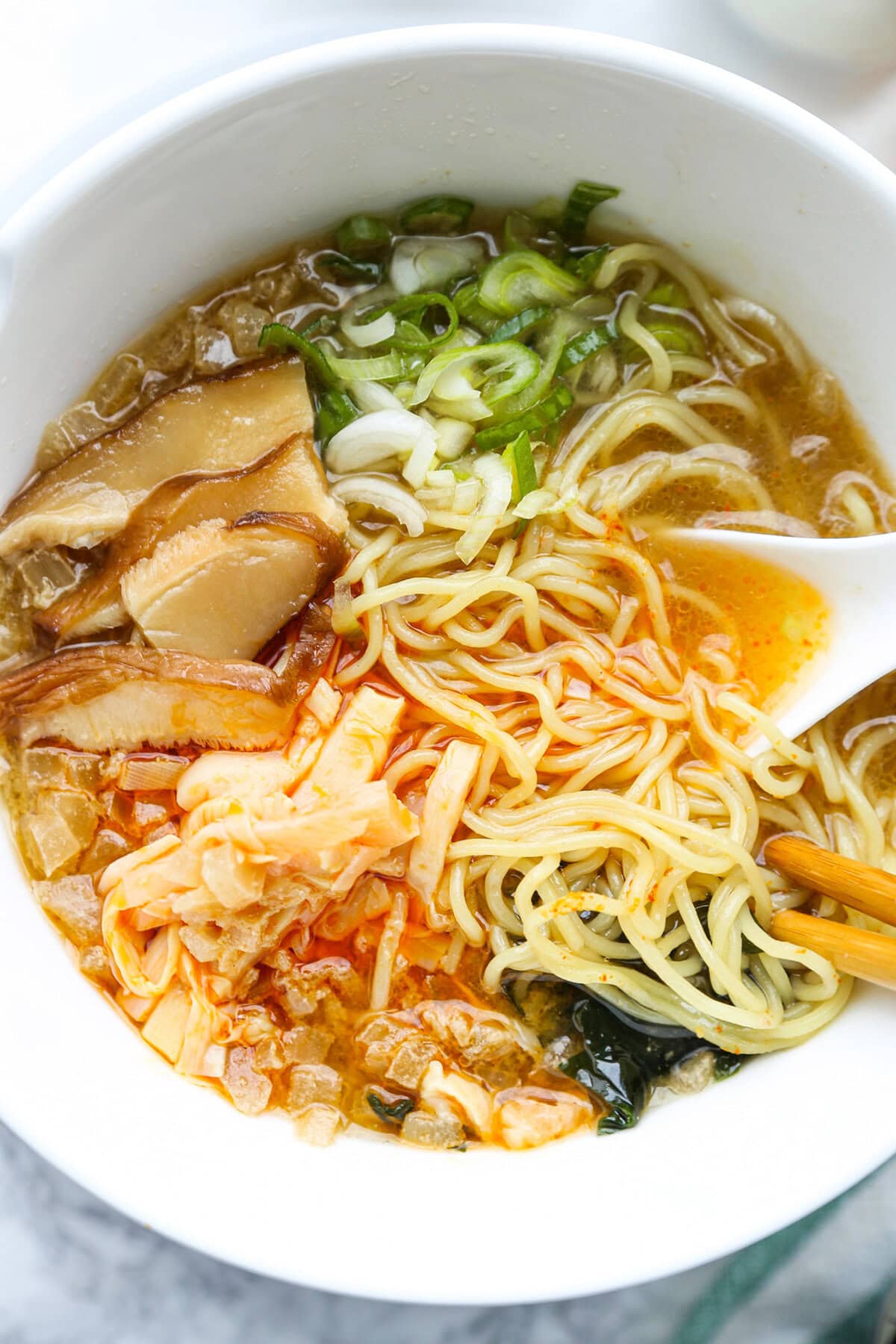
4. Serve with a bowl of steamed rice: For those who enjoy a heartier meal, offer a bowl of steamed rice as a side dish. Guests can enjoy a spoonful of rice with each bite of ramen, creating a satisfying combination of flavors and textures.
5. Garnish with fresh herbs: Sprinkle some freshly chopped cilantro, Thai basil, or mint over the ramen just before serving. The vibrant green herbs add a pop of color and a refreshing aroma that enhances the overall presentation and taste.
6. Provide traditional ramen spoons and chopsticks: Serve the Tonkotsu Vegetarian Ramen with traditional ramen spoons and chopsticks. This not only adds an authentic touch but also allows guests to fully immerse themselves in the traditional Japanese dining experience.
7. Accompany with Japanese green tea: Pair the ramen with a cup of hot Japanese green tea, such as sencha or genmaicha. The mild and refreshing flavors of the tea can cleanse the palate between bites and enhance the overall enjoyment of the meal.
8. Offer a variety of chili levels: If you enjoy spiciness, consider preparing a few chili options, such as chili flakes or hot sauce, to cater to different spice tolerances. Guests can then adjust the heat level of their ramen to suit their preference.
Remember to present the ramen in beautiful bowls, showcasing the vibrant colors of the broth, noodles, and toppings. Encourage your guests to fully immerse themselves in the ramen experience by slurping the noodles, as it is a customary practice in Japanese culture and signifies enjoyment.
With these serving suggestions, you can create a memorable dining experience with Japanese Tonkotsu Vegetarian Ramen. Enjoy the interplay of flavors, textures, and aromas as you savor each spoonful of this comforting and satisfying dish.



